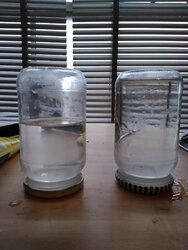Yellow Fang
Squire
- Location
- Reading
Look at that. Pure hydrogen that is (one on the left). The other one has pure oxygen in it. I don't know why there is so much less oxygen then hydrogen. I think there should be half as much, but it's less than that. Maybe more of the electrode was not under cover of the jar, or maybe more of the oxygen dissolved in the water. Oxygen does dissolve in water, doesn't it, which is very useful, because fish breathe it.


